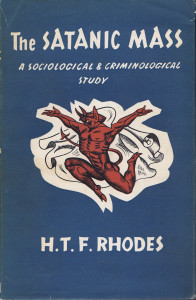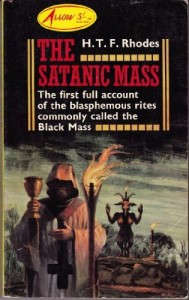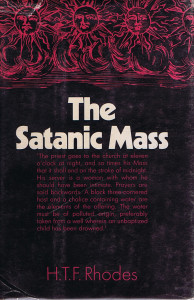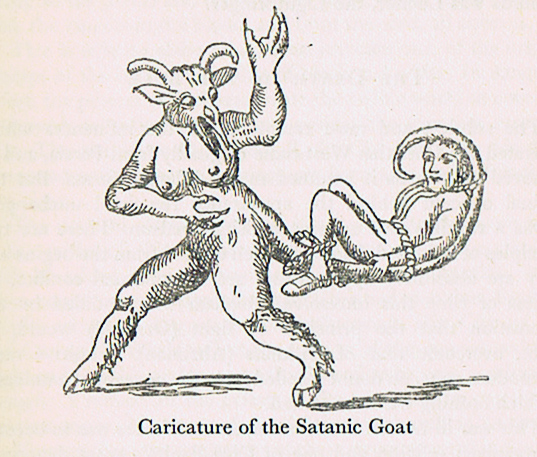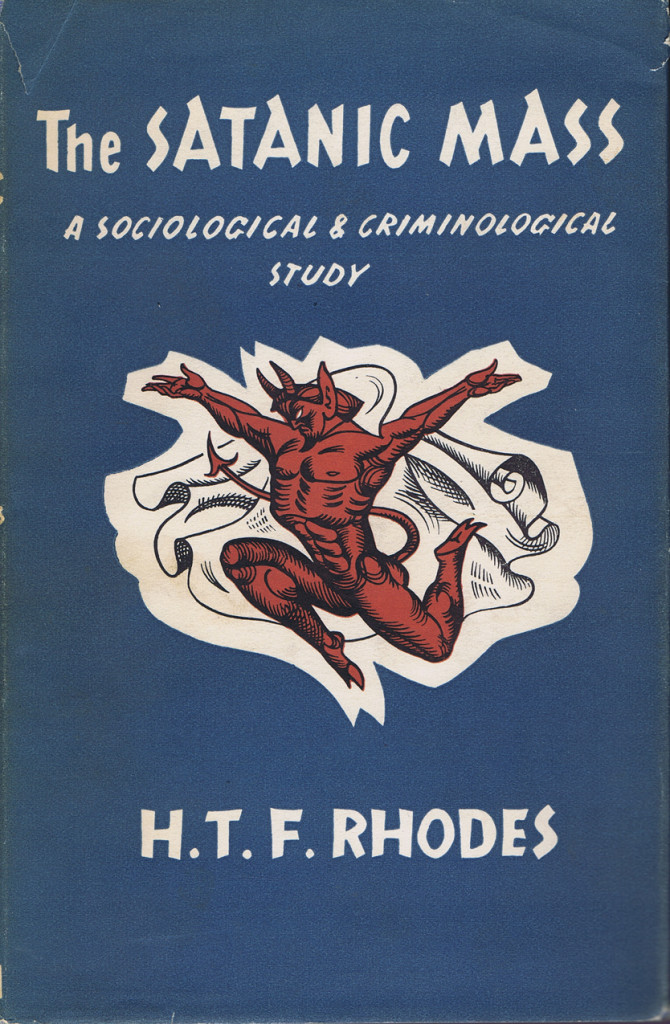
Subtitle: A Sociological And Criminological Study
Author: H. T. F. Rhodes
Edition Cited in The Compleat Witch
Publisher: Citadel Press
City: New York
Year: 1955
Pages: 232
Binding: Hardback
Size: 8.5″ x 5.5″
Dust Jacket Flap Copy
THE SATANIC MASS
This is the first fully documented account ever written of the seret rites of what is commonly called the Black Mass.
In his remarkable expose of this mystery cult, which bedevilled [sic] orthodox Christianity for centuries, the author has turned up many queer facts and brought to light a group of strange and bizarre personalities. It is a story at once fantastic and grotesque, but there is good comedy in it as well. Here are almost incredible things which nevertheless happened and are perhaps happening still.
Mr. Rhodes starts by showing how the “rite and idea of Satan” has its origin in primitive myth; he traces its evolution through the Manichaeans, Cathars, the witch cult and the Templars down to the seventeenth century, when it was caught up in a vicious crime wave, and then to the eighteenth century when it became in England the monstrous plaything of rakes and dandies.
In this book is explained for the first time what the Satanic secrets really were, the real nature of the charges made against the Knights Templar, why the worshippers of Satan say their prayers “backwards,” and the true nature of many other strange rites and ceremonies of primitive origin which survive even to the present day.
His chapters on La Voisin and the Gibourg Mass, in which one of Louis XIV’s mistresses was involved, being drawn from the papers of the Chambre Ardente, throw new light upon this strange passage in French history. His description of nineteenth-century Satanism, being founded upon the original sources, is also new.
Containing much material never before published and a new presentation of the classic evidence, this curious and fascinating study should become an indispensable source-book for all future works on the subject.
ABOUT THE AUTHOR
Mr. Rhodes is a well-known writer in the field of scientific crime detection, and is also professionally engaged in the examination of legal and historical documents.
He was one of the few English studnets of the Instutute of Lyon, France, under the distinguished Dr. Edmond Locard, one of the most famous forensic scientists in Europe.
He was also a research chemist in the “Conan Doyle” Laboratory of Chemical Research, Dept. of Technical Police, Prefecture of the Rhone. He is the author of many books, including Some Persons Unknown (John Murray), Genius and Criminal (John Murray), The Criminals We Deserve (Methuen), etc.
Table of Contents
PART I
ORIGINS
I… The Antique Gods… 15
II… By the Deceit of Devils… 26
PART II
THE MIDDLE YEARS (REVOLUTION)
Sources and Evidence
III… The Theoreticians… 35
IV… The Legists… 39
V… Prelude to the Mass… 46
VI… Sabbat of the Goat… 51
VII… The Black Turnip… 59
VIII… The Black Mass Priests… 66
IX… Vain Observance:
i. The Children of Satanael… 73
ii. The Overturned Chalice… 75
iii. The Mass of the Holy Ghost… 78
PART III
THE LATER PHASE (CRIME)
X… 17th-Century Background… 85
XI… The Beautiful Heretic… 90
XII… La Reynie and His Police… 98
XIII… The Organizers… 105
XIV… The Gibourg Mass… 112
XV… The Estate of the Clergy… 118
PART IV
THE FINAL STAGE (BURLESQUE AND FARCE)
XVI… Underground… 127
XVII… The Unholy Twelve… 131
XVIII… The Franciscan Disorder… 138
XIX… The White Mass Priests:
i. The Facts… 146
ii. The Vision and Creed… 151
iii. The Passing of Dr. Johannes… 155
XX… The White Magician… 160
XXI… The Last of the Manichaeans… 166
XXII… ‘Dr. Bataille’… 172
XXIII… The Man of Provence… 179
XXIV… Great was Diana… 186
XXV… The Confession of Gabriel Jogand… 191
PART V
THE DEVIL IN THE 20TH CENTURY (CONCLUSION)
XXVI… The Devil and the Freemasons… 201
XXVII… The End of the Black Mass… 210
XXVIII… Indefinition Conclusion… 216
Appendices… 221
References… 225
Index… 229
Online Resources
Archive.org | GoodReads | Google Books | LibraryThing
OpenLibrary | Project Gutenberg | Wikipedia | WorldCat
Editions (Arranged By Year)
Additional Photos/Images
Miscellaneous Quotes
“She believed that Satan now had the advantage and that his triumph was assured.”
“[…] a contemporary coolly remarked that ‘From constraint proceed crimes which were unpracticed before; and devotion seldom produces a reformation of manners.'”
“It is one of the most striking characteristics of the middle period of the 17th century that murder by poison grew to an alarming extent, and that the principal practitioners of it were women. It was one of the less desirable symptoms of feminine emancipation.”
“Such people approach religion very much as a child, who has been badly taught, approaches arithmetic. ‘First you do this, and then you do that, and the (miraculous) result is so and so.'”
“[…] but whatever your principles, if you tell ordinary men and women that their bodies are the creation of an evil spirit, you are not entitled to complain if they behave accordingly.”
“Perhaps very few of them believed that the Black Mass induced the Devil personally to intervene on their behalf, but they were convinced that it might released some irresistible tide which taken at the flood led on to fortune.”
Rev. Byrd’s Book Review
© 2015 Daniel Byrd.
This review may not be reproduced, adapted, modified, or otherwise used for any purpose without written permission of the author.
A note about the cited edition of Henry Taylor Fowkes Rhodes’ The Satanic Mass (Citadel Press, 1955) is that it includes several illustrations as well as the subtitle, “A Sociological and Criminological Study” that most later editions lack.
Also, the use of the words “Satanic” and “Satanism” in a book such as this that predates the Church of Satan and Anton LaVey’s codifying of Satanism with The Satanic Bible is a possible source of some confusion with people who think that Satanism was around before the Church of Satan. But what’s happening here (and in similar texts that predate the CoS) is that the word is used as a common noun, not a proper noun. In Rhodes’ book, on a few occasions especially toward the beginning, the word “Satanism” is actually used in quotes, which helps confirm this. And while its capitalization as a common noun is technically incorrect, I believe the author did so because the name “Satan” would, indeed, be capitalized. However, the fact remains that no group or persons throughout history, referenced in The Satanic Mass or similar texts, have ever called themselves “Satanists” or their practice “Satanism.” Only authors like Rhodes use it as an umbrella term for anything historically diabolic or anti-Christian. It was Anton LaVey who boldly converted the word to a proper noun in 1966, calling his religion Satanism and its adherents Satanists.
Rhodes’ The Satanic Mass has interesting tidbits like creating a parallel between the popularity of the Black Mass during times of social tension or revolution as a means of rebellion. But instead of expounding on this further the author chooses to focus on the supposed criminality associated with the Black Mass with accounts from unscrupulous sources. Some of the outlandish accounts read like a book from the “Satanic Panic” era (1980s through the early 1990s), when people were accused of ridiculous atrocities in the name of Satan based on zero evidence.
But Rhodes champions the supposed skepticism of the time, saying, for example, “Although a Catholic, La Reynie was not interested in witch-hunting, as, for example, his predecessor De L’Ancre had been. His object was to investigate the facts of sorcery and witchcraft without any reference to their theological implications.” This assertion, insinuating a “just the facts, ma’am” approach by 17th century police toward the criminal aspects of the Black Mass seems like the author’s attempt to give his own presumptions more credibility.
Although Rhodes often gives credence to bombastic claims, such as La Voisin’s “confession” about the furnace in her home being used to dispose of the bodies of over 2,000 children who had been sacrificed in her Black Masses, he does at times display selective skepticism, usually found aimed at the works of others. For example, when referring to the author Jules Michelet, “There are, as elsewhere in such writings, great loads of rubbish, and the more solid residue of real evidence displays bewildering variations of credibility, but beneath it all the final concentrate is probably of greater value than that found in any other single document.” And again, “The preposterous Bataille in his Devil In The 19th Century embroiders his account with an illustration of the scene wherein the priest offers the sacrifice to an improbable demon sitting cross-legged upon a still more improbable altar, but there is nothing […] to justify these picturesque additions.”
Such healthy animadversions are found elsewhere, too, when describing the Sabbat: “The ceremony following, which was supposed to involved the mutilation and torture by slow fire of the priestess, ought perhaps to be accepted with a good deal of reserve as embroidery founded upon rumour. It does not square well with the rest of the ritual, and particularly the next phase of it.” Rhodes seems to have differentiated what stories were “embroidery founded upon rumour” verses what stories are the result of scrupulous and unbiased investigating (during a time when such was nonexistent) on nothing more than whims that likely reveal the author’s own biases
Dr. LaVey trims the fat in regards to the topic and some of its characters, like La Voisin, in The Satanic Rituals. Offering third-side approaches such as, “The supposed high point of the Black Mass, alleged to be the offering to Satan of an unbaptized human child, was not quite the way collectors of baptism fees gloatingly told it.” It will come as no surprise that Rhodes’ book lacks such a perspective, instead taking the rumors started by those “collectors of baptism fees” and their ilk and running with them.
Rhodes’ book doesn’t shy away from the role of women in the history of diabolical shenanigans. Generally peppered with snide overtones, one finds remarks like, “Madame Guyon’s Quietism at one extreme, and La Voisin’s poisons and Black Masses at the other were alike in being symptoms of feminine revolt against social institutions in decay which were to be replaced by the new social order of bourgeoisie. Satanism was an important ingredient of it because revolutions always begin with atrocities which in this case were largely organised and committed by women.”
Overall Rhodes’ The Satanic Mass has a pseudo-scholarly feel to it. It can be tedious and dry, but there is some fun stuff that can be found as the reader muscles through it.
Disclaimer
Due to the obscurity of some titles, the contents of The Compleat Witch Illustrated Bibliography Project may contain information that is inaccurate or incomplete. We encourage readers to submit corrections and pertinent addenda like images, quotes, or other information via The Compleat Witch Illustrated Bibliography Facebook page. Thank you.
